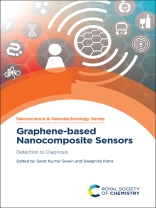Sensors are significantly relevant to many aspects of life. The advancements in nanotechnology-based sensing systems are giving rise to exciting developments in sensor applications. Recently, nanocomposites have become highly promising candidates for the designing of new chemical sensing and biosensing platforms.
Graphene-based nanocomposites have been successfully employed in many sensing applications in view of their excellent physical properties including high surface area, electrical conductivity, flexibility and optical transparency. They provide remarkable advantages such as lower fabrication costs, improved biocompatibility, prominent sensitivity, stability and selectivity for effective real-world implementation.
The aim of the book is to give an overview on the properties and novel applications of graphene-based nanocomposites as chemical and biosensors. Chapters highlight various biosensing applications such as diabetes monitoring, cancer cell detection, virus, bacteria, DNA, protein and amino acid sensing, as well as hormone and cholesterol detection. Moreover, chemical sensing applications like gas, alcohol, and food toxin sensing, heavy metal ion detection, and H2O2 sensing are also covered. The book is ideal for postgraduates, analytical chemists, biomedical scientists and researchers in both academic and industrial settings working on materials science, chemical science and nanotechnology.
สารบัญ
Graphene-based Nanocomposite Sensors: Present, Past and Future;Sensors and Biosensors: Types and Sensing Mechanism;Graphene-based Nanocomposites for Sensing;Graphene-based Polymer Nanocomposites for Sensing;Graphene Quantum Dots-based Nanocomposite as Fluorescence Sensors;Graphene-based Nanocomposites as Aptasensors;Graphene-based Nanocomposites for Alcohol Sensing;Graphene-based Nanocomposites for H
2O
2 Sensing;Graphene-based Nanocomposites for Detection of Food Toxins;Graphene-based Nanocomposites for Cancer Cell Detection;Graphene-based Nanocomposites for Glucose Sensing;Graphene-based Nanocomposites for Protein Sensing;Graphene-based Nanocomposites for Amino Acid Sensing;Graphene-based Nanocomposites for DNA Sensing;Graphene-based Nanocomposite Sensors for Detection of Pathogenic Bacteria;Graphene-based Nanocomposites for Hormone Detection;Graphene-based Nanocomposites for Cholesterol Detection;Graphene-based Nanocomposites for Detection of Small Biomolecules (AA, DA, UA, and Trp);Graphene-based Nanocomposite Sensors for Infectious Disease












